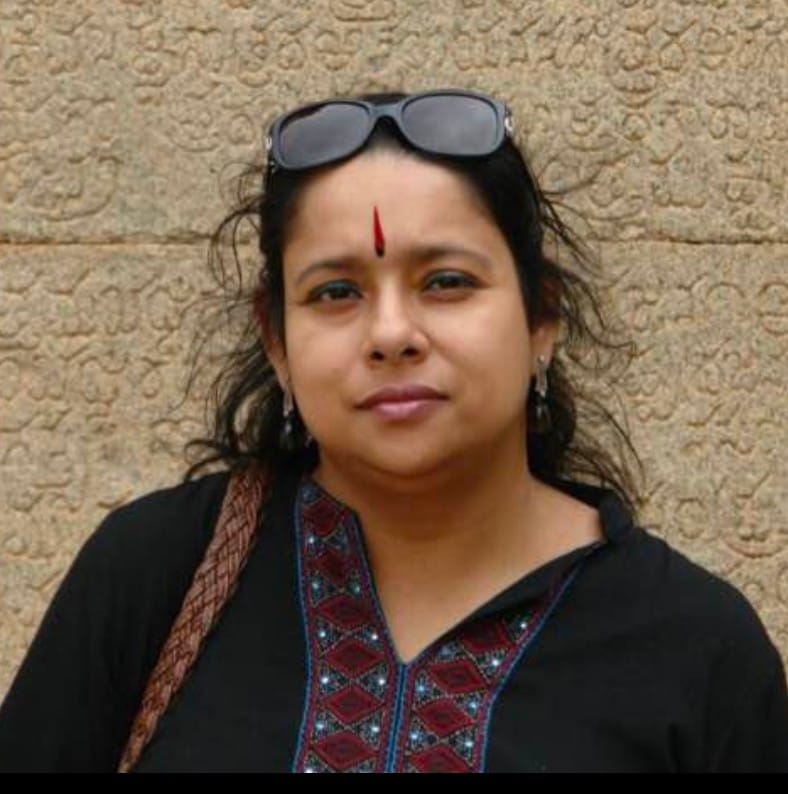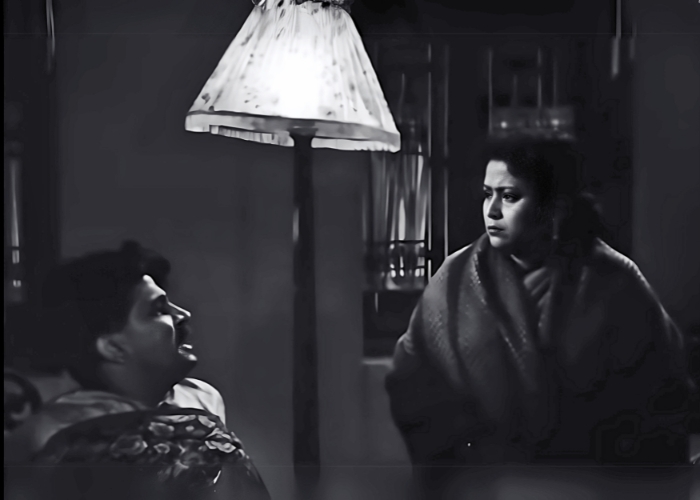
Once upon a time, her circumstances were such that MOLINA DEVI had to start her acting career at the tender age of eight. From being one of the dancers in 'Kinnari' that was staged at Minerva Theater to becoming the quintessential
Rani Rashmoni of the stage and the silver screen, Molina Devi made her way up through talent. Veteran actress MADHABI MUKHOPADHYAY revisits her life
both on and off screen
Why BFA commissioned this piece:
Among contemporary viewers of Bengali serials, it is the image of actress Ditipriya Roy that comes as an easy reference when there is a mention of Rani Rashmoni’s character. Few among them would know the stories from the life of the actress who had originally made this character so popular on stage and even the big screen. And who better to share those anecdotes from Molina Devi’s life than actress Madhabi Mukhopadhyay? Lending an ear to that narration is her daughter,
MIMI BHATTACHARYA
Molina Devi – the name brings back so many memories for me. I have shared space with her both on stage and on the shooting floor. Almost every experience on stage and screen has been enriching.
But she was not born as Molina Devi. As far as I remember, her real name was Molinmala. I really don’t know how she came into the film industry or why she had to join as a child artist at Minerva Theatre. But I have heard that she was barely eight years old when she was asked to play one of the shakhis in the play titled Kinnari. Life wasn’t easy for her at all. Sometimes those plays would extend till late in the night. The little girl would fall asleep by then and would be woken up from her slumber when time came for her to enter the stage along with the other shakhis.
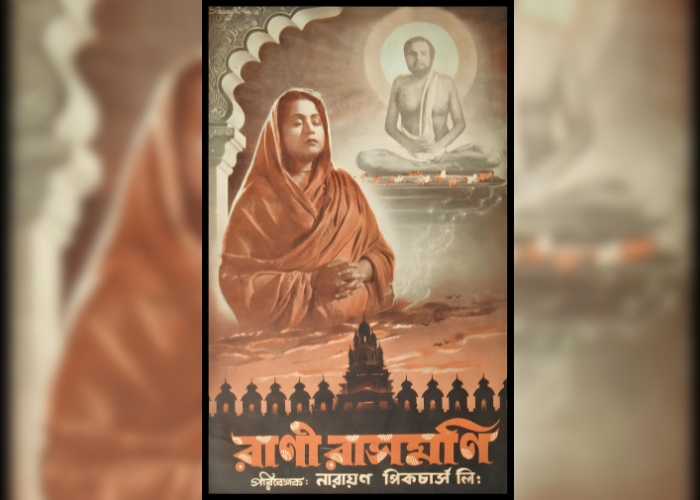
I was very small when I was introduced to her. I have memories of acting with her in a film titled Prarthana. It had Chhabi Biswas, Molina Devi and Supriya Devi. I had played the younger version of Supriya Devi. Chhabi Biswas was my father. That, I think, was my first film with him.
I wouldn’t know much about that phase but soon she gravitated towards acting on stage. She started doing plays like Jehangir and then, Kanthahar. But that tryst with theatre was short-lived. She had to wait till 1930 to make her debut in Bengali cinema. That happened with Tarakumar Bhaduri’s Srikanta. Thereafter, I think she acted in Priyanath Gangopadhyay’s Debi Chowdhurani and Prafulla Ray’s Chashar Meye.
I have heard that a huge villa on Prince Anwar Shah Road was bought to start New Theaters 2 studio just to shoot her dance sequences in this movie
Soon, Molina-di became one of the top actresses of New Theaters’ studios. Apart from acting, her excellent dancing skills had helped Molina Devi to outshine others. She was trained by Lalitmohan Goswami and Khemchand Prakash. I remember her dance performance from Hiren Bose's Mahua (1934). I have heard that a huge villa on Prince Anwar Shah Road was bought to start New Theaters 2 studio just to shoot her dance sequences in this movie.
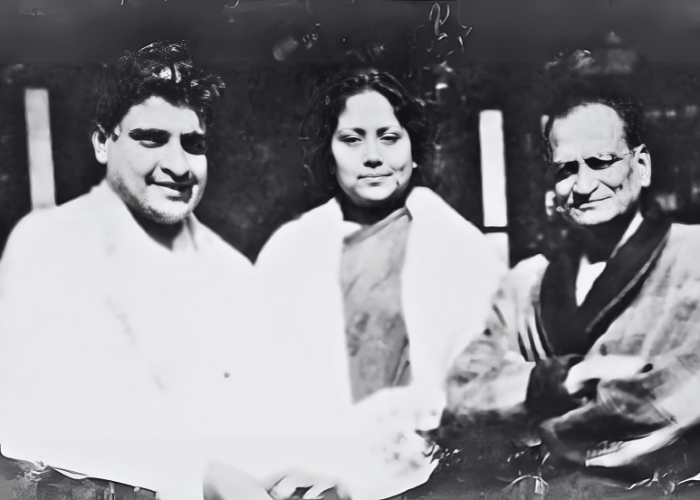
It is very important to also know about the personal life of Molina Devi. We all know about the famous composer Raichand Baral. Jolu Baral was his brother. Molina Devi and he had a relationship. She spent her entire life with him. One of the lesser known aspects about Molina Devi was her interest in grooming herself. Molina Devi might not have had the chance to get the formal education that she needed. But she always made it a point to read as much as possible. That was because of Jolu Baral’s encouragement. I have also the same trait in Sarajubala Devi. Both of them would get hold of foreign magazines so that they could try out new looks.
Despite the humble beginning, she built her niche in the film industry by the dint of her brilliant acting skills. She used to portray countless different types of characters with equal ease and poise. So many names of films come to mind when I talk about her. She was superb in Nishkriti. Then, there were films like Ramer Sumati, Bindur Chhele, Bikunther Will, Chhoto Bou, Mejo Bou, Annapurnar Mandir, Mahakabi Girishchandra, Saat Pake Bandha, Manmoyee Girls’ School, Chhaya Surja and Banpalashir Padabali. Who can forget her role in Sare Chuattor? She and Tulsi Chakraborty were just superlative there.
Molina Devi might not have had the chance to get the formal education that she needed. But she always made it a point to read as much as possible. That was because of Jolu Baral’s encouragement
I also have memories of watching her on stage. She had played the character of Bandana from Saratchandra’s Bipradas at Sisir Kumar Bhaduri’s Sreerangam. She was a regular at the plays that were staged by members of Mahila Shilpi Mahal - an organization set up by Kanan Devi to help senior female artists and do other charitable work. We, who were part of the organization, would enact plays. The proceeds of that were used for this purpose.
These plays were staged at Rabindra Sadan and Mahajati Sadan. All shows went houseful. I remember Molina Devi’s performance in the play, Mishar Kumari. It was directed by Sarajubala Devi and Molina Devi. Banani Chowdhury was the co-director. The play was staged at Mahajati Sadan and Molina Devi had played the role of Abon. Usually the celebrated actor, Ahin Choudhury (Ahindra Choudhury), used to enact that role. Molina Devi dressed up as a man to play the part and brought the character to life with her mesmerizing acting skills.
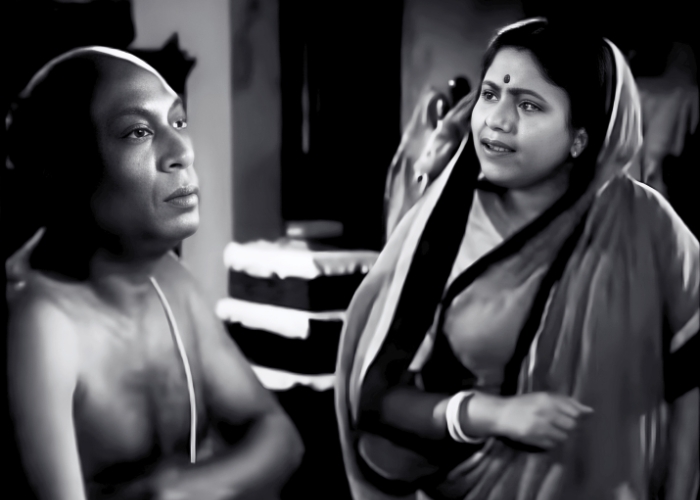
Molina Devi and Tulsi Chakraborty in Nirmal Dey's 'Sare Chuattar' (1953)
Stalwarts like Hemanta-da and Pahari Sanyal would come to watch every show without a miss. Each show was houseful and no seats were available. But Pahari Sanyal would not have a problem sitting on the stairs and watching it. Hemanta-da used to watch the play from the wings. When Molina Devi performed, Pahari Sanyal used to shout and say, "Oh, my dear! How well have you performed!”
Another play she did was Saratchandra’s Charatraheen where she essayed the role of Sabitri. At that time, she had put on a little bit of weight. In order to avoid looking heavy, she would drape georgette saris.
I have also watched her act in Jolu Baral’s adaptation of Maxim Gorky’s Mother. There would be call shows for that and she received a lot of praise for her performance in the stage adaptation.
One of the biggest contributions of Molina-di and Gurudas Bandyopadhyay for the stage was the formation of a theatre group called MG Enterprise. The word ‘MG’ was coined by using the initials of their names
One of the biggest contributions of Molina-di and Gurudas Bandyopadhyay for the stage was the formation of a theatre group called MG Enterprise. The word ‘MG’ was coined by using the initials of their names. Their first play was Thakur Ramakrishna and Jugadebata. She had played Rani Rashmoni in the play, Jugadebata. Gurudas Bandyopadhyay had played the role of Sri Ramakrishna in that play. Thereafter, Molina Devi also played the lead in Kali Prasad Ghosh's film titled Rani Rashmoni (1955).
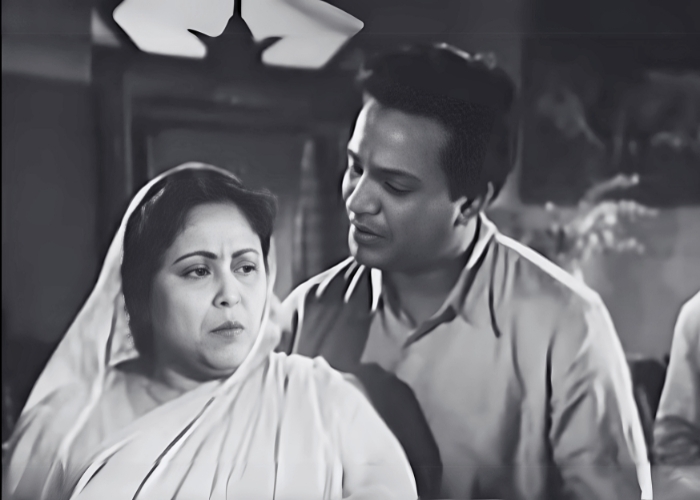
Uttam Kumar and Molina Devi in Ajoy Kar's 'Shyamali' (1956)
After the grand success of the film, Molina Devi and Gurudas Bandyopadhyay had again paired up in the theatre adaptation of Rani Rashmoni for nearly two decades. It's no wonder then that I cannot imagine anyone else playing the role of Rani Rashmoni except her.
I had also played a small part in the play, Rani Rashmoni. I used to play goddess Kali but my portrayal differed from the usual representations of the goddess as I didn't stick my tongue out. I used to stand opposite Molina Devi wearing a Benarasi sari. The clever arrangement of stage lights created the illusion that she, lost in her thoughts, suddenly disappears, as I become visible to the audience. In those days, many such intricate yet beautiful techniques were used to make theater all the more appealing. That appeal is missing from theater now.
News of her demise reached the studio when we were shooting for Nishkriti... We were shooting at Indrapuri Studio... In the 50s, Pashupati Chattopadhyay had first adapted Nishkriti. The elder daughter-in-law was played by Molina Devi while Sandhya Rani had essayed the role of the younger daughter-in-law
I had acted in a film with Molina Devi while playing Kali in Rani Rashmoni. At that time she had once asked me, “I wonder what's wrong with Gurudas? After speaking a few words he starts gesturing with his fingers. He can only think about God and nothing else seems to matter to him.”
Gurudas Babu had worked in several films and even comedies. One cannot discern anything odd or unusual about him on-screen. However, in real life, he repeatedly imitated the famous hand gesture of Sri Ramakrishna.
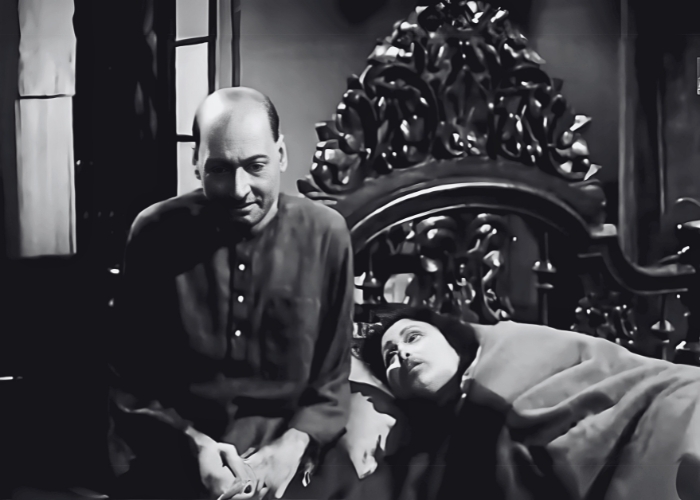
Molina Devi with Ahindra Chowdhury in Chitta Basu's 'Mantra Shakti' (1954)
I don’t exactly remember how she died. News of her demise reached the studio when we were shooting for Nishkriti. We were shooting at Indrapuri Studio. It was an adaptation of Saratchandra Chattopadhyay’s work. In the 50s, Pashupati Chattopadhyay had first adapted Nishkriti. The elder daughter-in-law was played by Molina Devi while Sandhya Rani had essayed the role of the younger daughter-in-law. Sometime around 1977, the same work was adapted again. The director was Sunil Basumullick. This time around Sandhya Rani had essayed the role of the elder daughter-in-law while I was cast as the younger daughter-in-law. While shooting we received the news of Molina Devi’s demise. We rushed to her residence.
After the demise of Molina Devi, the play Rani Rashmoni was never staged again. Strangely, at the same time, Gurudas Babu left everything behind and disappeared into oblivion.

